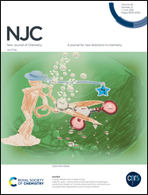The effect of electrolytes on the electrochromic performance of nickel-substituted tungstophosphate and TiO2 nanowire composite films†
Abstract
Polyoxometalates (POMs) with their unique physical and electrochemical nature have been a promising class of electrochromic (EC) materials. Although extensive research has been conducted, much effort has been devoted to the enhancement of the EC properties. Among a variety of factors, the electrolytes exhibit great influences on the EC properties. In this paper, we fabricated a composite film based on nickel-substituted Dawson-type tungstophosphate (P2W17Ni) and TiO2 nanowires by a two-step process involving hydrothermal treatment and a layer-by-layer method (LbL). As a result, the composite film displays transparent to dark blue in both Li+-based non-aqueous and H+-based aqueous electrolytes. Compared to the H+-based electrolyte, the composite film in Li+-based media shows a larger optical modulation of 53.3% and higher coloration efficiency of 85.6 cm2 C−1. The fast switching times of 7.7 s for coloration and 2.2 s for bleaching in Li+-based solution are observed. In addition, the composite film remains almost stable even after 800 cycles in Li+-based solution. The enhancement of the EC properties may be due to the unique nanowire structure, high insolubility and applied potential in Li+-based solution. These results make POMs attractive candidates for EC devices in both non-aqueous and aqueous electrolytes.



 Please wait while we load your content...
Please wait while we load your content...